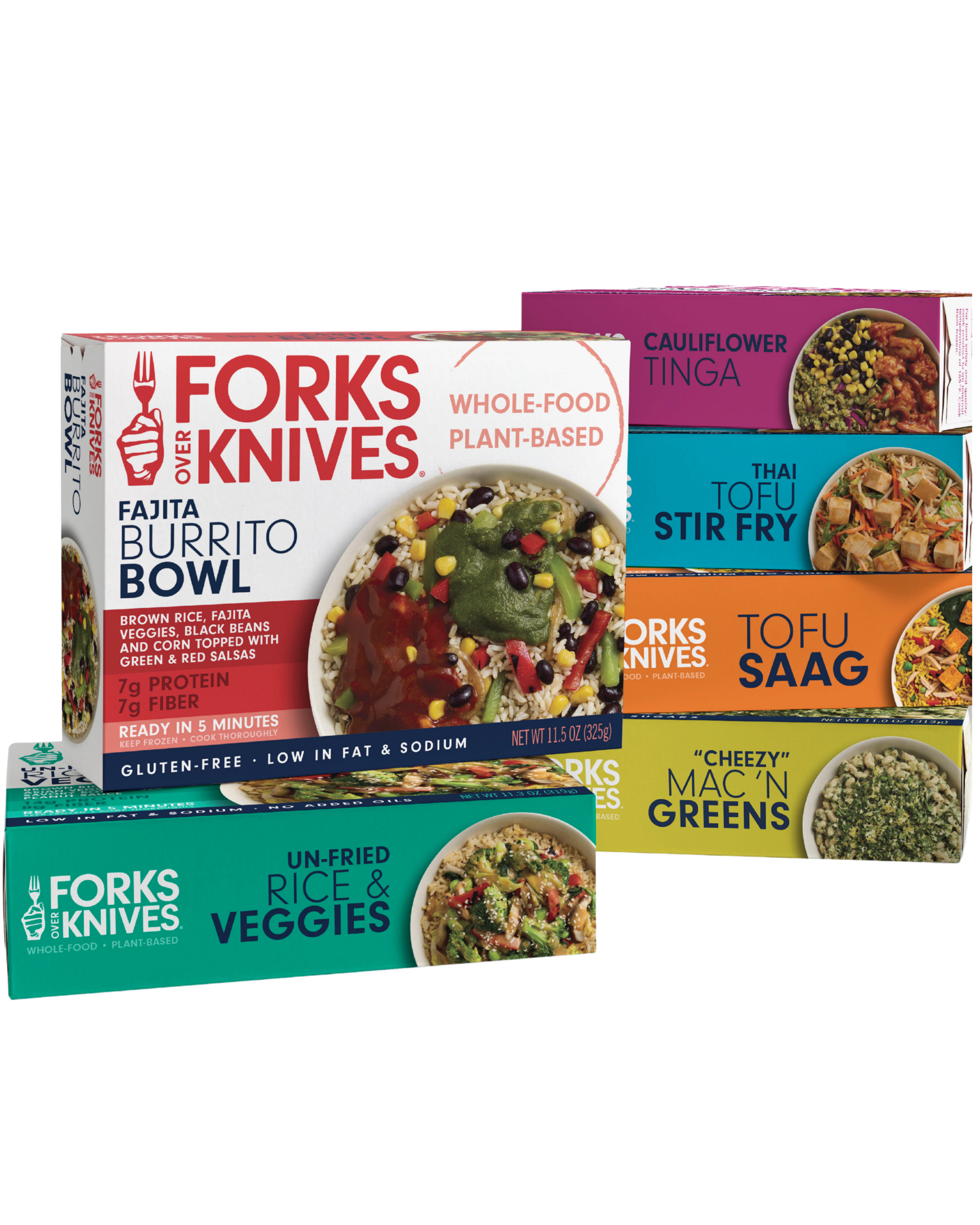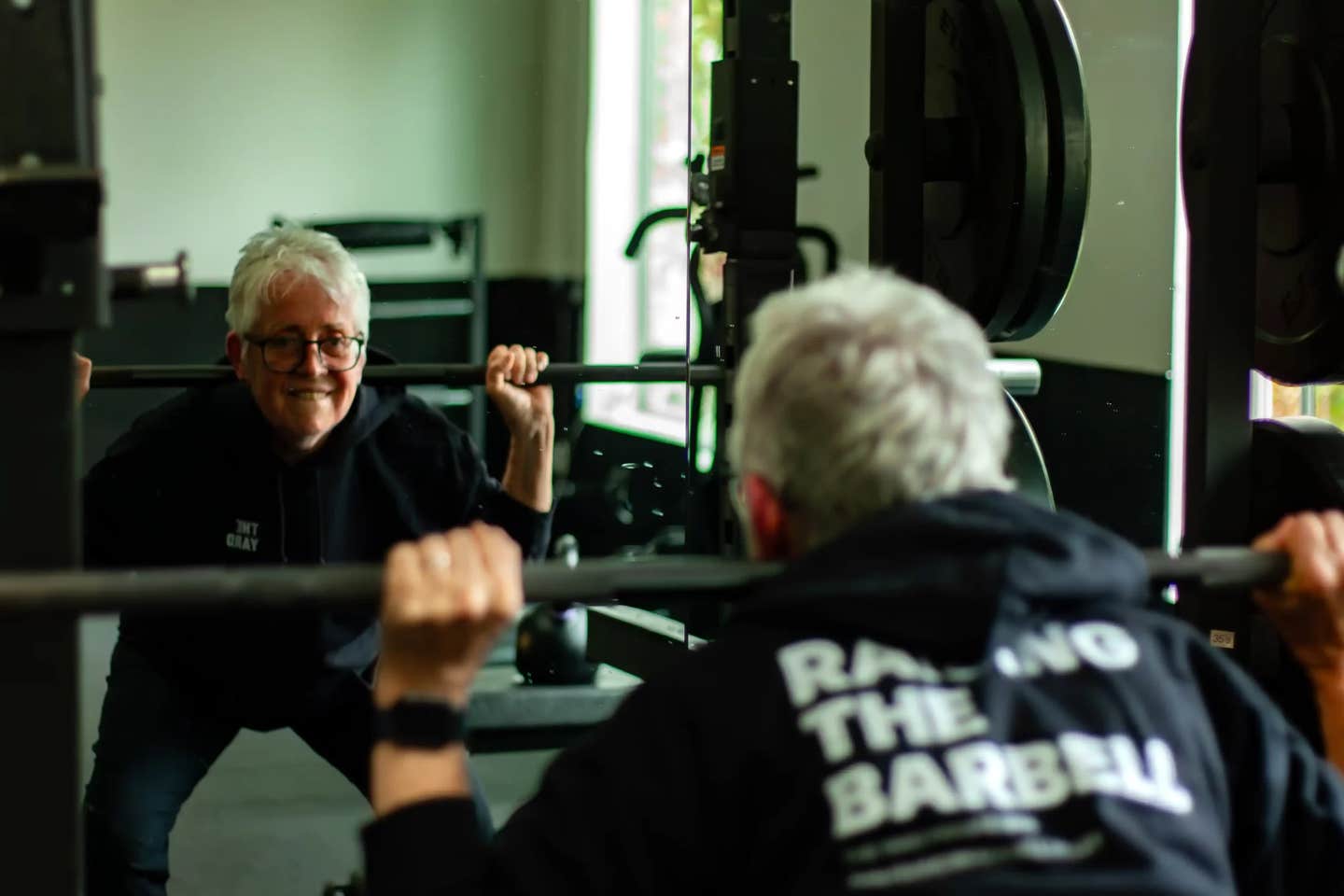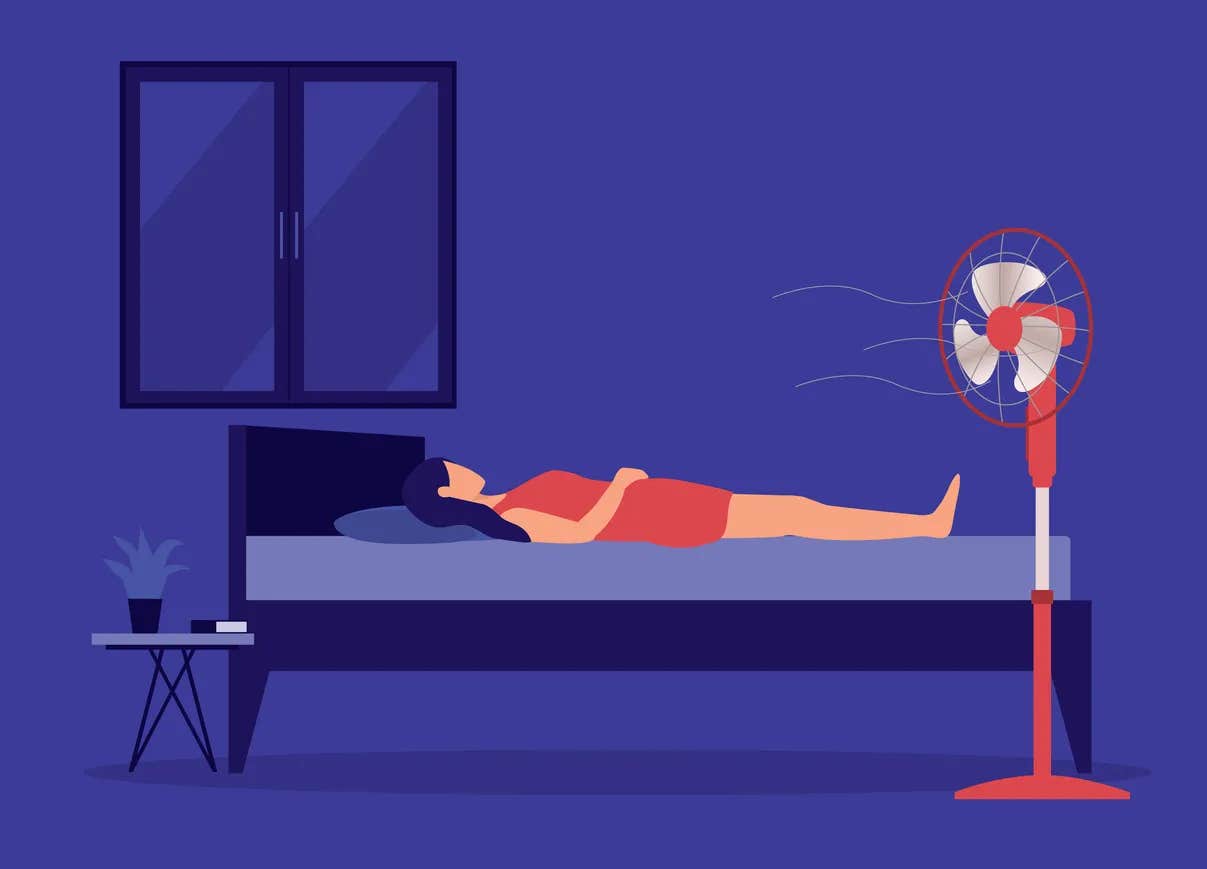Today, of course, we know that most proteins from both plants and animals are “complete proteins” (meaning they contain all of the essential amino acids we need).1 However, people sometimes use the term “low quality” to refer to plant proteins because they typically have a lower proportion of these essential amino acids as compared to animal proteins.
But it’s important to understand that having a higher proportion of essential amino acids, as animal protein does, is actually damaging (not advantageous) for our health. We outline seven ways that animal protein damages your health.
1. Animal Protein and Fiber (or total lack thereof)
Unlike plant protein, which comes packaged with fiber, antioxidants, and phytonutrients, animal protein comes with exactly none of the foregoing. To this point, meat, eggs, poultry, dairy, fish and other animal foods have absolutely no fiber whatsoever.
Many people, in their effort to “get enough” protein, tend to eat large amounts of animal foods, which displaces plant foods that have these important nutrients. Fiber deficiencies, in particular, are far more common than not.
For example, The Institute of Medicine recommends that men consume 38 grams of fiber, but the average adult only eats about 15 grams per day—less than half the recommended amount. In fact, according to the USDA, almost all Americans (~95%) do not get an adequate amount of dietary fiber.38,39
High fiber intake is associated with decreased cancer risk, specifically colon and breast cancers, as well as lower risk of ulcerative colitis, Crohn’s disease, constipation and diverticulitis. It may also reduce the risk of stroke, high cholesterol, and heart disease.40,41
2. Animal Protein and IGF-1 (increased cancer risk)
When we ingest proteins that have a higher proportion of the essential amino acids (which is a characteristic of animal protein), it results in our bodies producing higher levels of the hormone insulin-like growth factor-1 (IGF-1).2-8
This hormone stimulates cell division and growth in both healthy and cancer cells and, for this reason, having higher circulating levels of IGF-1 has been consistently associated with increased cancer risk, proliferation, and malignancy.2-8
3. Animal Protein and TMAO
Consuming animal protein also results in us having higher circulating levels of trimethylamine N-oxide (TMAO).
TMAO is a substance that injures the lining of our vessels, creates inflammation, and facilitates the formation of cholesterol plaques in our blood vessels. And that, of course, is highly problematic for cardiovascular health.9,10
TMAO is created by complex interactions involving our gut flora and the nutrients in the food we eat. And when we eat animal foods, it alters our gut flora in such a way that facilitates the creation of TMAO.9,10
So, consuming animal foods result in higher TMAO levels, which is damaging to our vessels. Even without all of the other problematic aspects of animal foods, this one issue involving TMAO is, according to the recent president of the American College of Cardiology Dr. Kim A. Williams, sufficient by itself for people to vigorously avoid animal foods.11
4. Animal Protein and Phosphorus
Animal protein contains high levels of phosphorus. And when we consume high amounts of phosphorus, one of the ways our bodies normalize the level of phosphorus is with a hormone called fibroblast growth factor 23 (FGF23).
FGF23 has been found to be harmful to our blood vessels. It can also lead to hypertrophy of the cardiac ventricle (abnormal enlargement of our cardiac muscle) and is associated with heart attacks, sudden death, and heart failure.12,13 So eating animal protein with its high concentration of phosphorus can result in increased levels of this hormone in our bodies, which in turn is highly problematic for our health.
5. Animal Protein, Heme Iron, and Free Radicals
Iron is the most abundant metal in the human body. We can consume it in two forms: (a) heme iron, found widely in animal foods like meat, poultry, and fish; and (b) non-heme iron found widely in plant foods.
One of the problems with heme iron is that it can convert less reactive oxidants into highly reactive free radicals.14 And free radicals can damage different cell structures like proteins, membranes, and DNA.14,15
Heme iron can also catalyze the formation of N-nitroso compounds in our bodies, which are potent carcinogens. So, not surprisingly, high intake of heme iron has been associated with many kinds of gastrointestinal cancers as well as other pathologies.15
It is true that heme iron has higher absorption rates and bioavailability than non-heme iron. However, iron itself can cause oxidative stress and DNA damage, so with iron generally, it’s not always a situation where “more is better.”15
While we definitely need iron, the absorption and bioavailability of iron from a well-rounded plant-based diet is generally adequate, and we can avoid the problems associated with heme iron and other negative health attributes of animal foods.16,17
6. Higher Sulfur-Containing Amino Acids and Bone Health Problems
Animal proteins also have, in general, higher concentrations of sulfur-containing amino acids, which can induce a subtle state of acidosis when metabolized.18 One of the mechanisms our bodies use to compensate for this acidosis is leaching calcium from our bones to help neutralize the increased acidity. Over time, this can have a detrimental effect on bone health.19-24
This is thought to be one of the reasons why some studies have found that populations with higher dairy consumption, as well as higher consumption of animal protein in general, also have a higher incidence of bone fractures.18-30
7. Animal Protein and Cholesterol
Most animal foods contain saturated fat and cholesterol (this is true for even so-called “lean” meats like chicken, turkey, and salmon, regardless of how they are cooked or prepared—even if boiled, baked, or steamed).
As humans, we do not need to consume any cholesterol, since our bodies synthesize all the cholesterol we need for our physiologic functions.
Eating cholesterol despite this fact is problematic for our health, as it increases our risk of developing heart disease—currently the No. 1 cause of death for both men and women in the United States.31-37
Atherosclerosis, or plaques of cholesterol that accumulate in the lining of our vessels, is exquisitely less common on a plant-based vegan diet devoid of animal products. And some studies have found that eating this way can even reverse atherosclerosis.32-37
The Real "High Quality" Foods
Given all the issues, the “high quality” aspect of animal protein might be more appropriately described as “high risk” instead.
And there’s no need to obsess about getting enough protein either. If you are eating a sensible variety of plant foods (e.g., vegetables, fruits, legumes, grains, roots, nuts, and seeds), and you are eating enough calories (i.e., you feel satisfied), there is no need to worry about protein adequacy.
The amino acids we need are structurally identical regardless of the source. However, as discussed above, there are serious health implications depending on whether the amino acids are packaged within animal or plant foods. Dr. Walter Willett, the chair of Harvard’s Department of Nutrition, said it well:
“To the metabolic systems engaged in protein production and repair, it is immaterial whether amino acids come from animal or plant protein. However, protein is not consumed in isolation. Instead, it is packaged with a host of other nutrients.”42
He therefore recommends that you “pick the best protein packages by emphasizing plant sources of protein rather than animal sources.”42
In the end, plant foods are the real “high quality” foods that we should be eating for optimal health.
Sources:
1.Young VR , Pellett PL. Plant proteins in relation to human protein and amino acid nutrition. Am J Clin Nutr. 1994;59(5 Suppl):1203S-1212S.
2. Dunaif GE, Campbell TC. Relative contribution of dietary protein level and aflatoxin B1 dose in generation of presumptive preneoplastic foci in rat liver. J Natl Cancer Inst. 1987;78(2):365-369.
3. Youngman LD, Campbell TC. Inhibition of aflatoxin B1-induced gamma-glutamyltranspeptidase positive (GGT+) hepatic preneoplastic foci and tumors by low protein diets: evidence that altered GGT+ foci indicate neoplastic potential. Carcinogenesis. 1992;13(9):1607-1613.
4. Campbell TC. Dietary protein, growth factors, and cancer. Am J Clin Nutr. 2007;85(6):1667.
5. Ornish D, Weidner G, Fair WR, et al. Intensive lifestyle changes may affect the progression of prostate cancer. J Urol. 2005;174(3):1065-1069.
6. Kleinberg DL, Wood TL, Furth PA, Lee AV. Growth hormone and insulin-like growth factor-I in the transition from normal mammary development to preneoplastic mammary lesions. Endocr Rev. 2009;30(1):51-74.
7. Allen NE, Appleby PN, Davey GK, Kaaks R, Rinaldi S, Key TJ. The associations of diet with serum insulin-like growth factor I and its main binding proteins in 292 women meat-eaters, vegetarians, and vegans. Cancer Epidemiol Biomarkers Prev. 2002; 1(11):1441-1448.
8. McCarty MF. Vegan proteins may reduce risk of cancer, obesity, and cardiovascular disease by promoting increased glucagon activity. Med Hypotheses. 1999;53(6):459-485.
9. Tang WH, Wang Z, Levison BS, et al. Intestinal microbial metabolism of phosphatidylcholine and cardiovascular risk. N Engl J Med. 2013;368(17):1575-1584.
10. Koeth RA, Wang Z, Levison BS, et al. Intestinal microbiota metabolism of L-carnitine, a nutrient in red meat, promotes atherosclerosis. Nat Med. 2013;19(5):576-585.
11. Interview with Kim A. Williams Sr., MD, President of the American College of Cardiology (August 25, 2015; Chicago). https://meatyourfuture.com/2015/09/interview-with-kim-a-williams-sr-md-president-of-the-american-college-of-cardiology-extended-version. Accessed December 18, 2016).
12. Xiao Y, Peng C, Huang W, et al. Circulating fibroblast growth factor 23 is associated with angiographic severity and extent of coronary artery disease. PLoS One. 2013;8(8):e72545.
13. Ozkok A, Kekik C, Karahan GE, et al. FGF-23 associated with the progression of coronary artery calcification in hemodialysis patients. BMC Nephrol. 2013;14:241.
14. Atamna H. Heme, iron, and the mitochondrial decay of ageing. Ageing Res Rev. 2004;3(3):303-318.
15. Ward MH, Cross AJ, Abnet CC, Sinha R, Markin RS, Weisenburger DD. Heme iron from meat and risk of adenocarcinoma of the esophagus and stomach. Eur J Cancer Prev. 2012;21(2):134-138. Available here: https://www.ncbi.nlm.nih.gov/pubmed/22044848 (accessed Jul. 4, 2016).
16. PJ Tuso, MH Ismail, BP Ha and C Bartolotto. Nutritional Update for Physicians: Plant-Based Diets. Perm J. 2013 Spring; 17(2): 61-66. Available here: https://www.ncbi.nlm.nih.gov/pmc/articles/PMC3662288 (accessed Jul. 4, 2016)
17. WJ Craig and AR Mangels; American Dietetic Association. Position of the American Dietetic Association: Vegetarian Diets. J Am Diet Assoc. 2009 Jul; 109(7): 1266–82. Available here: https://www.ncbi.nlm.nih.gov/pubmed/19562864 (accessed Jul. 4, 2016).
18. E Giovannucci. Dietary Influences of 1,25(OH)2 Vitamin D in Relation to Prostate Cancer: A hypothesis. Cancer Causes Control. 1998 Dec; 9(6):567-82. Available here: https://www.ncbi.nlm.nih.gov/pubmed/10189042 (accessed Jul. 4, 2016).
19. Harvard T.H. Chan, School of Public Health: The Nutrition Source – Calcium and Milk: What’s Best for Your Bones and Health? Available here: https://www.hsph.harvard.edu/nutritionsource/calcium-full-story (accessed Jul. 4, 2016).
20. HC Sherman and AO Gettler. The Balance of Acid-Forming and Base-Forming Elements in Foods, and its Relation to Ammonia Metabolism. J. Biol. Chem. 1912 11: 323-338. Available here: https://www.jbc.org/content/11/4/323.citation (accessed Jul. 4, 2016).
21. D Feskanich, WC Willett, MJ Stampfer, GA Colditz. Protein Consumption and Bone Fractures in Women. Am J Epidemiol. 1996 Mar 1; 143(5):472-9. Available here: https://www.ncbi.nlm.nih.gov/pubmed/8610662 (accessed Jul. 4, 2016).
22. LA Frassetto, RC Morris Jr., DE Sellmeyer, A Sebastian. Adverse Effects of Sodium Chloride on Bone in the Aging Human Population Resulting from Habitual Consumption of Typical American Diets. J Nutr. 2008 Feb; 138(2):419S-422S. Available here: https://www.ncbi.nlm.nih.gov/pubmed/18203914 (accessed Jul. 4, 2016).
23. MM Adeva, G Souto. Diet-induced Metabolic Acidosis. Clin Nutr. 2011 Aug; 30(4):416-21. Available here: https://www.ncbi.nlm.nih.gov/pubmed/21481501 (accessed Jul. 4, 2016).
24. US Barzel, LK Massey. Excess Dietary Protein can Adversely Affect Bone. J Nutr. 1998 Jun; 128(6):1051-3. Available here: https://www.ncbi.nlm.nih.gov/pubmed/9614169 (accessed Jul. 4, 2016).
25. DM Hegsted. Calcium and Osteoporosis. J Nutr. 1986 Nov; 116(11): 2316-9. Available here: https://www.ncbi.nlm.nih.gov/pubmed/3794834 (accessed Jul. 4, 2016).
26. K Michaëlsson, A Wolk, S Langenskiöld, S Basu, EW Lemming, H Melhus and L Byberg. Milk Intake and Risk of Mortality and Fractures in Women and Men: Cohort Studies. BMJ. 2014; 349: g6015. Available here: https://www.ncbi.nlm.nih.gov/pubmed/25352269 (accessed Jul. 4, 2016).
27. D Feskanich, HA Bischoff-Ferrari, L Frazier and WC Willett. Milk Consumption During Teenage Years and Risk of Hip Fractures in Older Adults. JAMA Pediatr. 2014 Jan; 168(1): 54–60. Available here: https://www.ncbi.nlm.nih.gov/pmc/articles/PMC3983667/ (accessed Jul. 4, 2016).
28. HC Sherman, AR Rose and MS Rose. Calcium Requirement of Maintenance in Man. J. Biol. Chem. 1920 44: 21-27. Available here: https://www.jbc.org/content/44/1/21.citation (accessed Jul. 4, 2016).
29. BJ Abelow, TR Holford and KL Insogna. Cross-cultural Association between Dietary Animal Protein and Hip Fracture: A hypothesis. Calcif Tissue Int. 1992 Jan; 50(1):14-8. Available here: https://www.ncbi.nlm.nih.gov/pubmed/1739864 (accessed Jul. 4, 2016).
30. LM Ausman, LM Oliver, BR Goldin, MN Woods, SL Gorbach and JT Dwyer. Estimated Net Acid Excretion Inversely Correlates with Urine pH in Vegans, Lacto-ovo Vegetarians, and Omnivores. J Ren Nutr. 2008 Sep; 18(5):456-65. Available here: https://www.ncbi.nlm.nih.gov/pubmed/18721741 (accessed Jul. 4, 2016).
31. Centers for Disease Control and Prevention website: Life Stages and Populations – Deaths – Leading Causes of Death. Available here: https://www.cdc.gov/nchs/fastats/leading-causes-of-death.htm (accessed Jul. 4, 2016).
32. CB Esselstyn Jr. Updating a 12-year Experience with Arrest and Reversal Therapy for Coronary Heart Disease (An Overdue Requiem for Palliative Cardiology). Am J Cardiol. 1999 Aug 1;84(3): 339-41, A8. Available here: https://www.ncbi.nlm.nih.gov/pubmed/10496449 (accessed Jul. 4, 2016).
33. CB Esselstyn Jr, G Gendy, J Doyle, M Golubic and MF Roizen. A Way to Reverse CAD? J Fam Pract. 2014 Jul; 63(7):356-364b. Available here: https://www.ncbi.nlm.nih.gov/pubmed/25198208 (accessed Jul. 4, 2016).
34. D Ornish, SE Brown, LW Scherwitz, JH Billings, WT Armstrong, TA Ports, SM McLanahan, RL Kirkeeide, RJ Brand and KL Gould. Can Lifestyle Changes Reverse Coronary Heart Disease? The Lifestyle Heart Trial. Lancet. 1990 Jul 21; 336(8708):129-33. Available here: https://www.ncbi.nlm.nih.gov/pubmed/1973470 (accessed Jul. 4, 2016).
35. CB Esselstyn Jr, SG Ellis, SV Medendorp and TD Crowe. A Strategy to Arrest and Reverse Coronary Artery Disease: A 5-year Longitudinal Study of a Single Physician’s Practice. J Fam Pract. 1995 Dec; 41(6):560-8. Available here: https://www.ncbi.nlm.nih.gov/pubmed/7500065 (accessed Jul. 4, 2016).
36. TC Campbell, B Parpia and J Chen. Diet, Lifestyle, and the Etiology of Coronary Artery Disease: the Cornell China Study. Am J Cardiol. 1998 Nov 26; 82(10B):18T-21T. Available here: https://www.ncbi.nlm.nih.gov/pubmed/9860369 (accessed Jul. 4, 2016).
37] CB Esselstyn Jr. Resolving the Coronary Artery Disease Epidemic Through Plant-Based Nutrition. Prev Cardiol. 2001 Autumn; 4(4):171-177. Available here: https://www.ncbi.nlm.nih.gov/pubmed/11832674 (accessed Jul. 4, 2016).
38. Usual Intake from Food and Beverages 2007-2010 Compared To Dietary Reference Intakes; Part E. Section 2: Supplementary Documentation to the 2015 DGAC Report. Scientific Report of the 2015 Dietary Guidelines Advisory Committee. Available here: https://health.gov/dietaryguidelines/2015-binder/meeting2/docs/refMaterials/Usual_Intake_072013.pdf (accessed Jul. 4, 2016).
39. NS Rizzo, K Jaceldo-Siegl, J Sabate and GE Fraser. Nutrient Profiles of Vegetarian and Nonvegetarian Dietary Patterns. J Acad Nutr Diet. 2013 Dec; 113(12):1610-9. Available here: https://www.ncbi.nlm.nih.gov/pubmed/23988511 (accessed Jul. 4, 2016).
40. JY Wick. Diverticular disease: Eat your fiber! Consult Pharm. 2012 Sep; 27(9): 613-8. Available here: https://www.ncbi.nlm.nih.gov/pubmed/22982746 (accessed Jul. 4 2016).
41. A Dilzer, JM Jones and ME Latulippe. The Family of Dietary Fibers: Dietary Variety for Maximum Health Benefit. Nutrition Today. 2013 May/June; 48(3):108-118. Available here: https://journals.lww.com/nutritiontodayonline/Abstract/2013/05000/The_Family_of_Dietary_Fibers__Dietary_Variety_for.5.aspx (accessed Jul. 4, 2016).
42. PJ Skerrett and WC Willett. Essentials of healthy eating: a guide. J Midwifery Womens Health. 2010 Nov-Dec; 55(6): 492-501. Available here: https://www.ncbi.nlm.nih.gov/pubmed/20974411 (accessed Jul. 4, 2016).
Related News
Get Our Best Price On The Forks Meal Planner

Forks Meal Planner takes the guess work out of making nutritious meals the whole family will enjoy.
Master Plant-Based Cooking!

Our new course features over 100 lessons, 50+ recipes, downloadable guides, and more!
New Frozen Meals!

Introducing our new frozen meals: Doctor-recommended, chef-crafted, & ready in minutes.




